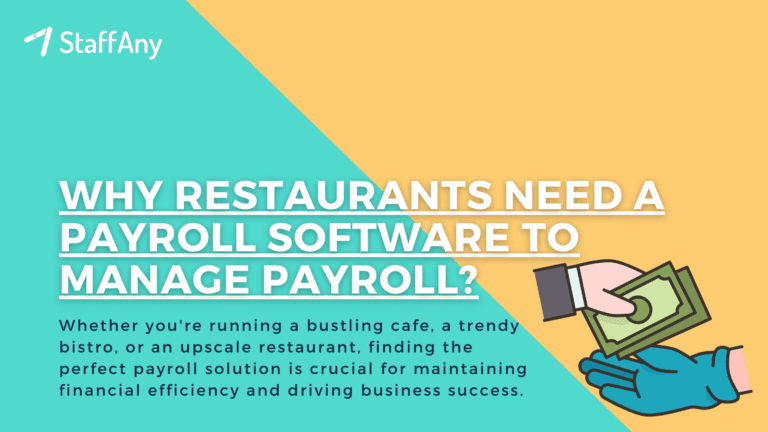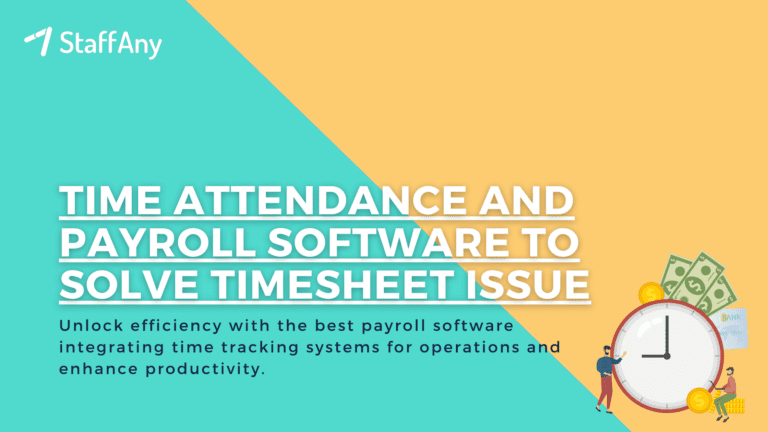Employee turnover rate is a crucial indicator of the health and stability of a company and can impact a wide range of aspects, including productivity, morale, and costs. In the F&B industry, where competition is high and the workforce is often made up of low-skilled and low-wage employees, turnover can be especially challenging.
In this article, we will discuss the definition and importance of employee turnover rate, factors contributing to high turnover in the F&B industry, strategies for reducing employee turnover, and how to measure and analyse turnover rate.
What is Employee Turnover Rate?

Employee turnover rate is the percentage of employees who leave a company over a specified period of time. It’s often described in relation to employee retention rate, which measures the number of employees retained from the beginning of a set period until the end.
The importance of employee turnover rate cannot be overstated. High turnover rates can indicate a lack of employee engagement, low morale, and a lack of job satisfaction. On the other hand, low turnover rates can indicate a positive workplace culture and engaged employees who are satisfied with their jobs.
Read more: Understanding Employee Management System and Its Benefits
How To Analyze Your Turnover Rate?
It is hard to say what is a healthy turnover rate as it depends on a company and its specific situation. Thus, employee turnover should always be evaluated contextually.
By examining these key indicators, you can gain insights into your organization’s turnover trends and potential areas for improvement. Here’s a simplified approach to calculate employee turnover rate:
1. Voluntary vs. Involuntary Turnover
Differentiate between voluntary and involuntary turnover. Voluntary turnover refers to employees who voluntarily resigned or retired, while involuntary turnover includes employees who were terminated or laid off. Analyzing these two categories separately can help identify different underlying factors and develop appropriate strategies.
2. New Hire Turnover
Evaluate the turnover rate specifically for new hires within a defined timeframe, such as the first six months or one year of employment. This indicator can shed light on the effectiveness of your recruitment and onboarding processes, as well as the fit between new hires and the organization.
3. Department or Team Turnover
Analyze turnover rates at the department or team level. This allows you to identify specific areas within your organization that may experience higher turnover rates, signaling potential issues with management, work environment, or job satisfaction.
4. Tenure-Based Turnover
Examine turnover rates based on employee tenure. Calculate turnover rates for different tenure groups, such as employees with less than one year, one to three years, three to five years, and so on. This analysis can provide insights into retention challenges at different stages of employees’ careers.
5. High-Performing Employee Turnover
Identify the turnover rate among high-performing employees or top talent. Losing high performers can have a significant impact on an organization, so monitoring turnover in this group is crucial. It may indicate issues related to compensation, career growth, or work environment.
Read more: 10 Employee Retention Programs to Retain Your Top Talents
Steps to Calculate Employee Turnover Rate

Before starting to calculate employee turnover rate, you must first choose the time frame; this could be either a month, quarter, or year. Then, follow these three steps to measure the employee turnover rate:
1. Gather Necessary Data
To measure your employee turnover rate, you will need to collect these three pieces of information first:
Number of employees at the start of the period
Number of employees at the end of the period
Total number of employees that left during that period.
2. Find the Average Number of Employees
To find the average turnover rate, you need to determine the average of the employees at the start and end of a specific time frame. Here’s the formula to calculate your average number of employees:
Average number of employees = (number of employees at the start + number of employees at the end) : 2
For instance, if a company had 42 employees at the start of the year and 62 at the end of it, the average number of employees would be:
Number of employees at the start = 42
Number of employees at the end = 62
Average number of employees = (42 + 62) : 2 = 52
3. Measure the Turnover Rate Percentage
After finding the average employee turnover rate, then you can calculate turnover rate percentage. But first, you need to find how many employees who left the company during that period. Here’s the final turnover rate formula for calculating employees leave:
Annual turnover rate = (number of employees who left : average number of employees) x 100
Using the same example, there’s a total of 13 employees who left during that period, the turnover rate percentage would be:
Number of employees who left = 13
Average number of employees = 52
Annual turnover = (13 : 52) x 100 = 25%
Read more: 12 Employee Engagement Activities to Keep Your Staff Happy and Motivated
Factors Contributing to High Employee Turnover Rate in the F&B Industry

The F&B industry is known for its high employee turnover rates, with many employees leaving for many reasons. Some of the factors contributing to high employee turnover rates in the F&B industry include the following:
1. Low Wages and Benefits
One major factor contributing to high employee turnover in the F&B industry is low wages and inadequate benefits. In many cases, employees are not paid enough to support themselves or their families, leading to financial stress and job dissatisfaction. When employees are not compensated fairly for their hard work, they are more likely to leave for better opportunities elsewhere.
2. Poor Working Conditions
Poor working conditions, such as unhealthy or unsafe environments, can also contribute to high employee turnover rates in the F&B industry. When employees are not provided with a comfortable and safe work environment, they may feel discouraged and dissatisfied with their job, which can lead to increased absenteeism and high turnover rates.
Read more: Understanding Manpower Planning and Its Importance in F&B
3. Lack of Advancement Opportunities
Many employees in the F&B industry see their jobs as stepping stones to better career opportunities, and a lack of advancement opportunities can lead to frustration and dissatisfaction. When employees do not see opportunities for growth and professional development within their organisation, they may become frustrated and seek out new job opportunities.
4. Inadequate Employee Training and Support
Inadequate employee training and support can also contribute to high employee turnover rates in the F&B industry. When employees are not provided with the proper training and support, they may struggle to perform their job duties effectively.
Lack of training and support can lead to frustration, stress, and ultimately, a desire to seek employment elsewhere. Additionally, when employees do not feel supported in their job, they may become demotivated and disengaged, which can also result in increased turnover rates.
5. Workload and Stress
The F&B industry is known for demanding work schedules and high levels of stress, which can lead to burnout and increased employee turnover. When employees are overworked and stressed, they may become disillusioned with their job and seek out a better work-life balance elsewhere.
Read more: Understanding the Importance of Human Resource Planning
Strategies for Reducing Employee Turnover Rate in the F&B Industry
Reducing employee turnover rates in the F&B industry is essential to maintain a stable and engaged workforce. Some strategies that can help organisations reduce employee turnover rates include the following:
1. Offering Competitive Wages and Benefits
Offering competitive wages and benefits is crucial in reducing employee turnover rates. In the F&B industry, many employees are attracted to jobs that provide higher wages, better benefits, and a positive work environment. Organisations can increase employee satisfaction and retain their best employees by providing these incentives.
2. Improving Working Conditions
Working conditions, including the physical environment and scheduling, can significantly impact employee satisfaction and turnover rates. Providing a comfortable and safe work environment, flexible scheduling options, and opportunities for advancement can help improve employee morale and reduce turnover.
3. Encouraging Work-Life Balance
Encouraging work-life balance can help reduce stress levels and improve overall employee satisfaction. This can be achieved by allowing employees to have flexible work hours, paid time off, and opportunities for telecommuting. By promoting a healthy work-life balance, organisations can reduce turnover and improve employee retention.
4. Fostering a Positive Workplace Culture
A positive workplace culture can greatly impact employee satisfaction and turnover rates. Organisations can foster a positive company culture by promoting open communication, creating opportunities for team building, and recognizing and rewarding employee contributions.
Organisations can reduce employee turnover rate and improve employee retention by creating a positive and supportive work environment.
5. Providing Opportunities for Career Advancement
Providing opportunities for career advancement can be a crucial factor in reducing employee turnover rates. Employees are more likely to stay with an organisation if they feel that their careers are progressing and that they are learning and growing in their roles.
Read more: HR Management Softwares, Privilege or Necessity
6. Health and Wellness Programs
Offer health and wellness initiatives, such as gym memberships, yoga classes, or mental health support services. Healthy employees are generally happier and more engaged in their work.
7. Regular Feedback and Communication
Provide regular feedback to employees about their performance and offer constructive guidance for improvement. Also, encourage employees to voice their concerns and suggestions, fostering a sense of belonging and involvement.
8. Recognition of Work-Life Achievements
Acknowledge significant life events of employees, such as birthdays, work anniversaries, or personal achievements. Small gestures can make employees feel appreciated and valued.
9. Employee Surveys and Feedback
Conduct regular surveys to gather feedback from employees about their job satisfaction, work conditions, and concerns. Use this feedback to identify areas for improvement and take necessary actions.
If you are looking for ways to reduce employee turnover in your F&B business, consider turning to the experts at StaffAny. With extensive experience in the industry, the team at StaffAny can help you create a positive workplace culture, improve working conditions.
By partnering with StaffAny, you can ensure that your business attracts and retains the best employees, and enjoy long-term success and growth. Visit StaffAny today to learn more and get started!
Strategies for Reducing Employee Turnover Rate in the F&B Industry
Reducing employee turnover rates in the F&B industry is essential to maintain a stable and engaged workforce. Some strategies that can help organisations reduce employee turnover rates include the following:
1. Offering Competitive Wages and Benefits
Offering competitive wages and benefits is crucial in reducing employee turnover rates. In the F&B industry, many employees are attracted to jobs that provide higher wages, better benefits, and a positive work environment. Organisations can increase employee satisfaction and retain their best employees by providing these incentives.
2. Improving Working Conditions
Working conditions, including the physical environment and scheduling, can significantly impact employee satisfaction and turnover rates. Providing a comfortable and safe work environment, flexible scheduling options, and opportunities for advancement can help improve employee morale and reduce turnover.
3. Encouraging Work-Life Balance
Encouraging work-life balance can help reduce stress levels and improve overall employee satisfaction. This can be achieved by allowing employees to have flexible work hours, paid time off, and opportunities for telecommuting. By promoting a healthy work-life balance, organisations can reduce turnover and improve employee retention.
4. Fostering a Positive Workplace Culture
A positive workplace culture can greatly impact employee satisfaction and turnover rates. Organisations can foster a positive workplace culture by promoting open communication, creating opportunities for team building, and recognizing and rewarding employee contributions. Organisations can reduce employee turnover rate and improve employee retention by creating a positive and supportive work environment.
5. Providing Opportunities for Career Advancement
Providing opportunities for career advancement can be a crucial factor in reducing employee turnover rates. Employees are more likely to stay with an organisation if they feel that their careers are progressing and that they are learning and growing in their roles.
Organisations can support employee career growth by offering training and development programs, mentorship opportunities, and opportunities for advancement within the company. By providing these opportunities, organisations can increase employee satisfaction, improve retention, and reduce turnover.
If you are looking for ways to reduce employee turnover in your F&B business, consider turning to the experts at StaffAny. With extensive experience in the industry, the team at StaffAny can help you create a positive workplace culture, improve working conditions. By partnering with StaffAny, you can ensure that your business attracts and retains the best employees, and enjoy long-term success and growth. Visit StaffAny today to learn more and get started!











